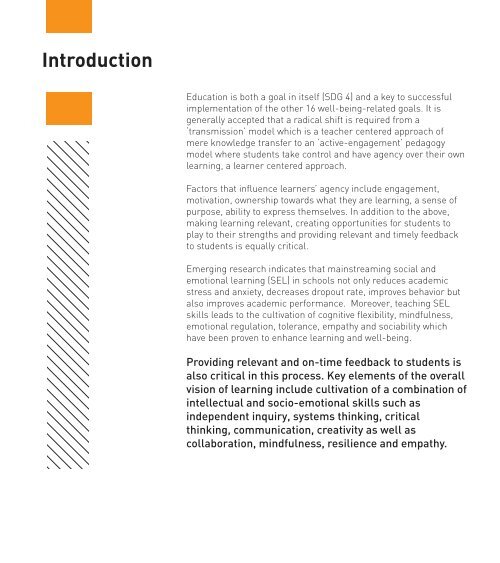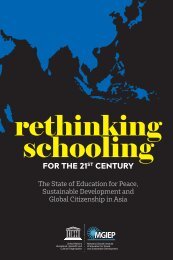Industry Guidelines on Digital Learning: Discussion Draft
The guidelines offered in this document are a first draft to provide a holistic system of characteristics and parameters important for delivering active and engaging learning through digital solutions.
The guidelines offered in this document are a first draft to provide a holistic system of characteristics and parameters important for delivering active and engaging learning through digital solutions.
You also want an ePaper? Increase the reach of your titles
YUMPU automatically turns print PDFs into web optimized ePapers that Google loves.
Introducti<strong>on</strong><br />
Educati<strong>on</strong> is both a goal in itself (SDG 4) and a key to successful<br />
implementati<strong>on</strong> of the other 16 well-being-related goals. It is<br />
generally accepted that a radical shift is required from a<br />
‘transmissi<strong>on</strong>’ model which is a teacher centered approach of<br />
mere knowledge transfer to an ‘active-engagement’ pedagogy<br />
model where students take c<strong>on</strong>trol and have agency over their own<br />
learning, a learner centered approach.<br />
Factors that influence learners’ agency include engagement,<br />
motivati<strong>on</strong>, ownership towards what they are learning, a sense of<br />
purpose, ability to express themselves. In additi<strong>on</strong> to the above,<br />
making learning relevant, creating opportunities for students to<br />
play to their strengths and providing relevant and timely feedback<br />
to students is equally critical.<br />
Emerging research indicates that mainstreaming social and<br />
emoti<strong>on</strong>al learning (SEL) in schools not <strong>on</strong>ly reduces academic<br />
stress and anxiety, decreases dropout rate, improves behavior but<br />
also improves academic performance. Moreover, teaching SEL<br />
skills leads to the cultivati<strong>on</strong> of cognitive flexibility, mindfulness,<br />
emoti<strong>on</strong>al regulati<strong>on</strong>, tolerance, empathy and sociability which<br />
have been proven to enhance learning and well-being.<br />
Providing relevant and <strong>on</strong>-time feedback to students is<br />
also critical in this process. Key elements of the overall<br />
visi<strong>on</strong> of learning include cultivati<strong>on</strong> of a combinati<strong>on</strong> of<br />
intellectual and socio-emoti<strong>on</strong>al skills such as<br />
independent inquiry, systems thinking, critical<br />
thinking, communicati<strong>on</strong>, creativity as well as<br />
collaborati<strong>on</strong>, mindfulness, resilience and empathy.<br />
Pedagogies that support deeper learning,<br />
including pers<strong>on</strong>alized learning strategies,<br />
collaborative learning, situated and c<strong>on</strong>nected<br />
learning, are effective in fostering the<br />
above-menti<strong>on</strong>ed skills in students. , ,<br />
Fostering learner participati<strong>on</strong> and offering<br />
pers<strong>on</strong>alized and customized learning<br />
opportunities are key to student engagement.<br />
Technology enabled learning offers exciting<br />
innovative, interactive and immersive ways for<br />
augmenting deeper, engaging and active<br />
learning experiences. There is a need to create<br />
a ‘digital ecosystem for learning’ which should<br />
be optimally integrated to build new digital<br />
pedagogies for the 21st century.<br />
<strong>Digital</strong> pedagogies combine pedagogical<br />
approaches with technological infrastructure<br />
and tools to facilitate teaching and learning<br />
(Ibid.) Some examples of digital pedagogies<br />
could comprise learning platforms, immersive<br />
interfaces, digital games and digital<br />
tech-books.<br />
FOREWORD | INTRODUCTION | GUIDELINES | CONCLUSION | AUTHORS & REVIEWERS | REFERENCES<br />
PURPOSE | PRINCIPLES | STRUCTURE | MANDATORY GUIDELINES | RECOMMENDED GUIDELINES


















